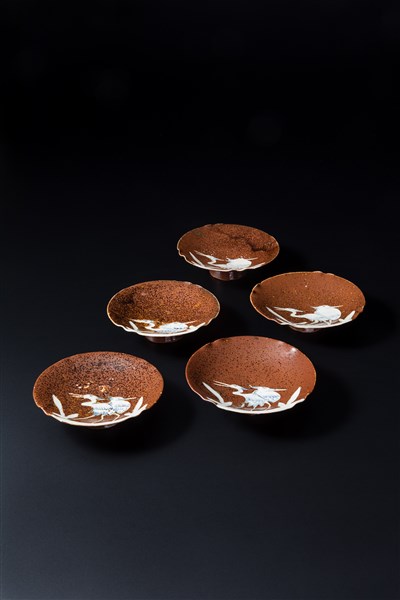鉄釉染付鷺文向付
- 佐賀県・有田窯
- 江戸時代
- 17世紀
- 鉄釉染付磁製
- H-4.2 D-14
解説(春の玉手箱)
以前吸坂焼(吸坂手)と呼ばれた作品であるが、有田の山小屋窯等から同種の破片が出土している。薄手に轆轤成形した後、縁の四方を摘み変化を付けており、高めに削り出された高台とともに洒落たデザインとなっている。全体に鉄釉を掛けて、表面に白抜きによって二羽の白鷺を表し、羽毛や表情を染付で表している。器形と衒わない筆致の染付が見事に融け合った、この種の皿中では出色の出来栄えであり、五客揃っていることも貴重である。なお、同窯の製作と思われる皿が、滴翠美術館(兵庫県芦屋市)に所蔵されている。
Catalogue Entry
This type of ware was formerly called Suisaka ware, but shards of this same type have been excavated from the Yamagoya kiln and other sites in Arita. Thinly formed on the wheel, the edges of these dishes were then pinched into four corners. These features combine with a high, carved foot to create an elegant dish design. The entire dish has been covered with iron glaze, and two white egrets are shown in a patch of white, unglazed clay left on the front of each dish. The details of the birds, their feathers and expressions, are drawn in underglaze blue. The shape of these dishes blend perfectly with the unpretentious underglaze blue decoration. The ware is particularly well excuted for this type of ware and the matched set of five dishes is a rare example of the ware. Dishes thought to have been fired at the same kiln are also found in the Te‐kisui Museum in Ashiya city, Hyogo prefecture.
